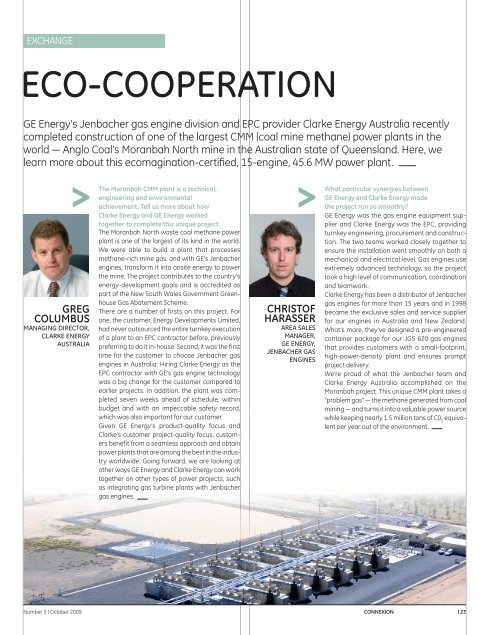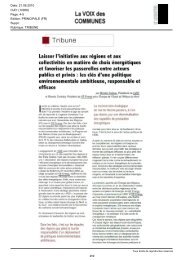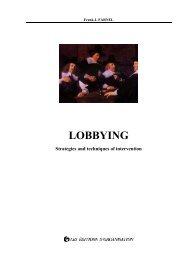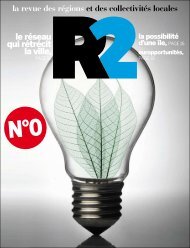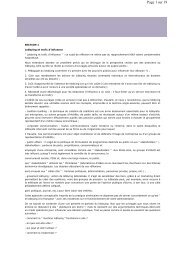GE ENErGy - Frank Farnel
GE ENErGy - Frank Farnel
GE ENErGy - Frank Farnel
Create successful ePaper yourself
Turn your PDF publications into a flip-book with our unique Google optimized e-Paper software.
EXCHAN<strong>GE</strong><br />
eCo-CooperaTion<br />
<strong>GE</strong> Energy’s Jenbacher gas engine division and EPC provider Clarke Energy Australia recently<br />
completed construction of one of the largest CMM (coal mine methane) power plants in the<br />
world — Anglo Coal’s Moranbah North mine in the Australian state of queensland. Here, we<br />
learn more about this ecomagination-certifi ed, 15-engine, 45.6 MW power plant.<br />
GREG<br />
COLUMBUS<br />
Managing DireCTor,<br />
ClarKe energY<br />
aUSTralia<br />
the Moranbah CMM plant is a technical,<br />
engineering and environmental<br />
achievement. tell us more about how<br />
Clarke Energy and gE Energy worked<br />
together to complete this unique project.<br />
The Moranbah North waste coal methane power<br />
plant is one of the largest of its kind in the world.<br />
We were able to build a plant that processes<br />
methane-rich mine gas, and with <strong>GE</strong>’s Jenbacher<br />
engines, transform it into onsite energy to power<br />
the mine. The project contributes to the country’s<br />
energy-development goals and is accredited as<br />
part of the New South Wales Government Greenhouse<br />
Gas Abatement Scheme.<br />
There are a number of firsts on this project. For<br />
one, the customer, Energy developments Limited,<br />
had never outsourced the entire turnkey execution<br />
of a plant to an EPC contractor before, previously<br />
preferring to do it in-house. Second, it was the first<br />
time for the customer to choose Jenbacher gas<br />
engines in Australia. Hiring Clarke Energy as the<br />
EPC contractor with <strong>GE</strong>’s gas engine technology<br />
was a big change for the customer compared to<br />
earlier projects. In addition, the plant was completed<br />
seven weeks ahead of schedule, within<br />
budget and with an impeccable safety record,<br />
which was also important for our customer.<br />
Given <strong>GE</strong> Energy’s product-quality focus and<br />
Clarke’s customer project-quality focus, customers<br />
benefit from a seamless approach and obtain<br />
power plants that are among the best in the industry<br />
worldwide. Going forward, we are looking at<br />
other ways <strong>GE</strong> Energy and Clarke Energy can work<br />
together on other types of power projects, such<br />
as integrating gas turbine plants with Jenbacher<br />
gas engines.<br />
CHRISTOF<br />
HARASSER<br />
area SaleS<br />
Manager,<br />
ge energY,<br />
JenBaCher gaS<br />
engineS<br />
what particular synergies between<br />
gE Energy and Clarke Energy made<br />
the project run so smoothly?<br />
<strong>GE</strong> Energy was the gas engine equipment supplier<br />
and Clarke Energy was the EPC, providing<br />
turnkey engineering, procurement and construction.<br />
The two teams worked closely together to<br />
ensure the installation went smoothly on both a<br />
mechanical and electrical level. Gas engines use<br />
extremely advanced technology, so the project<br />
took a high level of communication, coordination<br />
and teamwork.<br />
Clarke Energy has been a distributor of Jenbacher<br />
gas engines for more than 15 years and in 1998<br />
became the exclusive sales and service supplier<br />
for our engines in Australia and New Zealand.<br />
What’s more, they’ve designed a pre-engineered<br />
container package for our JGS 620 gas engines<br />
that provides customers with a small-footprint,<br />
high-power-density plant and ensures prompt<br />
project delivery.<br />
We’re proud of what the Jenbacher team and<br />
Clarke Energy Australia accomplished on the<br />
Moranbah project. This unique CMM plant takes a<br />
“problem gas” — the methane generated from coal<br />
mining — and turns it into a valuable power source<br />
while keeping nearly 1.5 million tons of C0 2 equivalent<br />
per year out of the environment.<br />
Number 3 l October 2009 CONNEXION l 23


